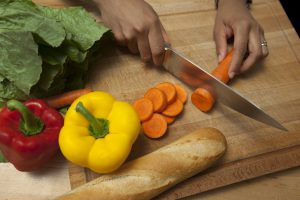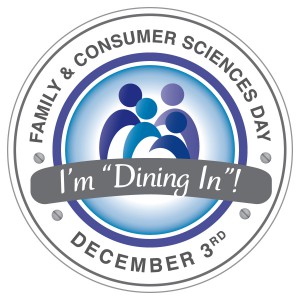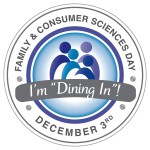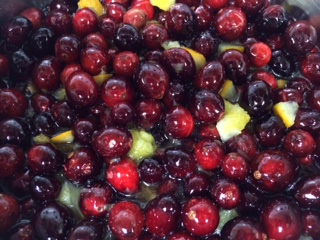
by Angela Hinkle | Feb 8, 2019
Do you know what the different types of cholesterol are in your body? Do you know what your cholesterol levels are? Do you know why your numbers matter? Cholesterol can be a contributing factor to heart disease. It’s important to understand your numbers so you can take the best care of yourself. Making simple changes in your daily routine can help reduce your risk of heart disease. Talking to your doctor is the first step so he or she can request blood tests to help determine your risk. One of the tests the doctor may run is called a lipid profile, which checks your body’s cholesterol.
What should my cholesterol numbers be?
- Total cholesterol should be somewhere between 125 to 200 mg/dL
- LDL cholesterol is called “bad” because it can block your arteries. The level should be less than 100 mg/dL. If it starts with “L”, aim for a lower number.
- HDL cholesterol is called “good” because it helps to clear out the LDL (bad) cholesterol. This number should be greater than 40 mg/dL for men and greater than 50 mg/dL for women. If it starts with “H”, aim for a higher number.
- Triglycerides are fat found in the blood. You want these numbers to be less than 150 mg/dL.
If you don’t understand what your numbers mean, be sure to talk with your health care provider. The more you know about your numbers, the more incentive you have to make any recommended changes.
What Can Cause Unhealthy Levels of Cholesterol?
- Habits like smoking, lack of physical activity, and unhealthy eating patterns.
- Genetics (family medical history)
- Some medications

Prepping for a healthy diet
Photo source: UF/IFAS
What Can You Do to Help Lower the “Bad” Cholesterol and Increase the “Good” Cholesterol?
You can make simple changes to your daily routine to help reduce your risk of heart disease.
Eat more heart-healthy foods
- Eat foods like oatmeal, apples, and pears to give your body more soluble fiber.
- Add salmon, walnuts, and flaxseed to your diet. These are great sources of Omega-3 fatty acids.
- Eat less red meat and switch from whole or 2% milk to skim milk.
Move!
- The Mayo Clinic recommends 30 minutes of exercise at least 5 times a week.
- Find out more about how to fit physical activity into your day
Stop Smoking!
- There are many different resources available to help you or someone you know quit smoking.
- Check out how to quit for quitting tobacco tips from A to Z
Drop those extra pounds
- If you lose just 5% of your body weight, it can help your heart!
- See what a 5% weight loss can do for your health
By making simple changes to your diet and lifestyle, you can help to reduce the risk of heart disease. Change takes time and effort, so don’t get discouraged by trying to make all the changes at once! Pick one habit to work on, such as slowly switching from whole milk to 2% to 1% then finally to skim milk. Once drinking skim milk becomes part of your everyday routine, choose another habit to work on, such as getting more exercise. Adding a half hour walk in the morning or in the evening is a great way to get you moving. To make the walk even more enjoyable, take your dog with you – pets need exercise, too!
Your good health is why your numbers matter. Remember, small changes can make a big difference in improving your heart health. And since February is Heart Health Awareness month, now is a great time to start.
Contributing writer – UF Intern Jennifer Bryson

by Laurie Osgood | Jan 17, 2019
January 24th is Global Belly Laugh Day!

Make health and wellness a part of your calendar and daily routine.
Photo source: UF/IFAS Northwest District
Each year, we celebrate many holidays, but there are also many observances and commemorations scheduled throughout the calendar year. Some are odd, like National Science Fiction Day, Word Nerd Day, and even National Dinosaur Day. Others serve as a good opportunity to raise awareness about important health topics and remind us to take control of our health.
Celebrating the new year means leaving the past behind, making positive changes, and the continuation of success and happiness. National observances such as Breast Cancer Awareness Month, National Family Health History Day, and World AIDS Day help us come together to spread awareness and show support for each other.
Organizations such as the American Heart Association, American Cancer Society, and American Lung Association have created nationwide awareness month campaigns to draw attention to some of the leading causes of death in America. Other observances, such as Take a Loved One to the Doctor Month from the Florida Department of Health, encourage people to take charge of their own health and to urge their loved ones to do the same.
So, as you are looking forward to the new year, make health and wellness a part of your calendar and daily routine.
UF/IFAS Extension wishes you and your family a year fully loaded with happiness, prosperity, and health.
To learn more about health observances and how to encourage your loved ones to take control of their health, contact Laurie Osgood, Family and Consumer Sciences Agent at the UF/IFAS Extension Office in Gadsden County, (850) 875-7255, or osgoodlb@ufl.edu

by Angela Hinkle | Nov 26, 2018

FCS Dine In Day December 3
Is your busy, busy life making it difficult to spend time eating a meal at home with your family? Research tells us families are healthier in so many ways when they eat at home together. Maybe these favorite family meals from some of our readers will give you some inspiration.
Italian Night
My mother’s chicken cacciatore. She’s Italian and a great cook. She makes it with boneless chicken breasts, rice, sliced peppers, onions, tomatoes, and of course, garlic. It is so good and probably healthy. But maybe not, since I eat way too much of it. Friends and family come together on “Italian Night” to enjoy this and other Italian specialties. Molto delicioso. Rick W.
My favorite meal was always when my mom made homemade spaghetti sauce for pasta. Wow, that’s good stuff. When I brought my girlfriend home, it became one of her favorite meals too. Thanks mom! Alex H.

Father and son set the dinner table. Photo Source: Wendy Meredith
Home Away from Home Meal
My favorite family meal was pork chops, broccoli, mashed potatoes, rolls and sweet tea, because my son, (my first born), cooked his first meal in his first home away from home at the age of 21 and invited our family to dinner. He was always the one out of five children who liked to have everyone in the family sit at the dining room table together and enjoy a meal as often as possible. Our lives consisted of football, cheerleading, church events, ballet, gymnastics, soccer, school events, jobs, etc. Our family of seven was a very busy family and always running here and there, but somehow due to the persistency of our son, we managed to have one or two meals a week together as a family. I was a very happy and proud mom when I received the invite to have dinner that night. The food was delicious, but the fellowship during “My Favorite Family Meal” was something I will remember and cherish forever. Wendy M.
Let Them Eat Cake or Bread
Celebrations were very special in my family. Every year on my birthday, my grandmother would always cook my favorite food and bake my favorite cake (Red Velvet – Yum). When I was young I always thought it was about the food. But it was about so much more; we learned about manners and etiquette, and family coming together to share old traditions and make new ones. Whenever I see a red velvet cake or smell one baking, it brings back happy memories. I’m transformed back to when I was a 10 year old girl. Dorothy L.
Growing up on a farm in Michigan, I’ve got a lot of good memories involving food! From making butter in a churn, to picking blackberries in the woods for Mom to make pie, to getting ripe tomatoes from the garden for a tasty bacon and tomato sandwich and many more. I consider myself very fortunate to have grown up knowing exactly where our food comes from!
A favorite and happy memory is Mom making bread on cold days, letting the loaves rise by the heat registers, then baking it in the oven. The whole house smelled like delicious bread. Once it was done, Mom would cut it while it was still warm and give us thick slices with warm, melting butter on it! Cheryl V.
December 3rd is Dine In Day. It’s a chance to make a commitment to have a meal at home with family. So, make the decision to eat with your family at home this December 3rd.

FCS Dine In Day

by Angela Hinkle | Nov 21, 2018

FCS Dine In Day December 3
What’s your favorite family meal? Is it an event like a picnic or Super Bowl Party? Is it reoccurring like Wednesday night church dinner? Maybe it’s an annual meal like Thanksgiving. Check out some of these special Thanksgiving meals, then think about a favorite meal for your family to share on Dine In Day.
What about Sweet Potatoes?
I think my favorite holiday meal story is from about 10 years ago when our oldest daughter was away at college. She asked me what we were going to have for Thanksgiving Dinner and as I went through the list she said, “what about sweet potatoes?” to which I answered “but you don’t like sweet potatoes”. Then she said, “No, I don’t, but I they’re supposed to be on the table at Thanksgiving”!
It’s such a tiny thing, but it touched my heart because it meant she had fond memories and that our family holiday dinners meant something to her! PS – now she loves sweet potatoes and serves them to her family all the time! Susan H.
My “Found” Family

Favorite Fall Things
Photo Source:: Angela Hinkle
My favorite family meal of the year is on Thanksgiving, with my “found” family in Bradenton. Especially now that I live in Tallahassee, taking the trip down there to spend a few days with my best friend and her crazy family is definitely a highlight. It’s even more special now since I don’t get to see her every day anymore. Plus? Turkey and deviled eggs! Yummy. Sam K.
Memory We Will Always Cherish
My favorite meal happened 6 years ago during Thanksgiving. It was the first year that I hosted my own Thanksgiving dinner and my husband and I invited everyone we knew- family, friends, coworkers. We had 30 people share their holiday with us and we had so much fun. It was a lot of work and a lot of cooking, but it was so special to us. That day we were able to honor the ones we loved by hosting them and sharing that experience. One day, we will do that again. But for now, it’s a great memory that we will always cherish. Christina W.
Imagining Warm and Cozy
One of my most memorable meals was Thanksgiving when I was in the 11th grade. My family decided to go camping in our pop-up camper for the weekend at a nice campground in central Florida. In keeping with the season, a cold front passed through that weekend, dropping the temperature significantly. Our little camper did not have a heater, so we shivered in our bunks and scurried to the central bathhouse, passing motor homes and travel trailers with condensation on the windows, imagining how warm and cozy their occupants must be. Despite the frigid temperatures, we enjoyed a campground-wide Thanksgiving dinner with all the trimmings in the community room. We made fond memories of the weekend, which we still laugh about, and are thankful for a warm house and the comforts and conveniences of home to enjoy the holiday and everyday meals with family and friends. Judy C.

FCS Dine In Day
December 3rd is Dine In Day. It’s a chance to make a commitment to have a meal at home with family. Research tells us families are healthier in so many ways when they eat at home together. So, make the decision to eat with your family at home this December 3rd. Maybe you can tell us about your favorite family meal or be inspired to make new ones – for Thanksgiving or any time of year.

by Ginny Hinton | Nov 15, 2018

Cranberries cooking
It may seem like the year has barely started, but the holiday season is here! A little bit of planning now can go a long way toward avoiding that, “I blew my diet and need bigger jeans” feeling. Believe it or not, there are holiday treats that are nutritionally guilt-free, as long as you don’t go overboard. As with so many other things, moderation is the key! Below are some classic holiday favorite foods with hidden health benefits:
Sweet Potatoes: It’s no secret that sweet potatoes are good for you – but they may have even more benefits than you think! Sweet potatoes contain a lot of Vitamin A. That’s a great source of alpha and beta carotene that helps keep your eyes, bones and immune system in top shape. Sweet potatoes are also one of the top food sources of potassium, with almost twice as much of the mineral as you find in a banana. When choosing sweet potatoes, look for ones that are firm with tapered ends and a uniform shape and color. Miniature sweet potatoes are fun and pack the same great health benefits.
Cranberries: Bright red cranberries are a little too tart to eat alone but they add a beautiful festive touch to any holiday table. With only 45 calories per cup plus a healthy dose of Vitamin C and fiber, they’re a winner all the way around. Cranberries also have more disease-fighting antioxidants than almost every other fruit and vegetable. Buy cranberries fresh in the fall and winter and use them soon, as they don’t last long. Store them in a tightly sealed bag in your refrigerator to keep them fresh longer.
Nuts: Yes, they’re high in calories – and fat – but nuts are also loaded with vitamins and minerals. Eating a handful of nuts a few times a week may lower your risk of heart disease. Nuts are full of antioxidants, energy and protein. Think of nuts, in moderation, as a Christmas gift for your body!
Cocoa: What better way to begin – or end – the day than a steaming hot cup of chocolate? Knowing the health benefits of cocoa give us even more reason to love it. Remember those healthful antioxidants? Dark chocolate is loaded with them. In fact, if you choose dark chocolate with a high percent of cocoa solids, you may help lower your blood pressure, improve your blood vessel health and control your cholesterol. So, give in to those chocolate cravings – in moderation, of course!
There are lots of ways to make healthier holiday dishes. Check with your local UF/IFAS Extension Office for delicious recipe ideas that won’t break your budget or your waistline.

by Angela Hinkle | Nov 13, 2018

FCS Dine In Day December 3
Uncle Eddie wasn’t actually my uncle. He was my grandfather. But to most everyone in the small town in Connecticut where I spent many summers growing up, he was known as Uncle Eddie.

Edward Scordato aka “Uncle Eddie”
Every Saturday morning, Uncle Eddie got up at some ridiculously early hour and headed for the kitchen. He started a pot of coffee as well as a kettle for tea. He began making pancakes, toast, bacon or sausage, and eggs prepared in a variety of ways. (I think he honed his kitchen/organizational skills as a cook in the Army.)
Friends, neighbors, and relatives from all around came to my grandparents’ dining room and back patio to eat. Just as important, they came to socialize, catch up on how everyone was doing, and hear the latest personal and public events of the week. There was a little gossip and lots of talk of religion and politics. (As a kid, those last two subjects bored me like nothing else could.)
Some folks stayed for 20 minutes. Some stuck around for the whole morning. Uncle Eddie made sure everyone who came got fed. And not just food for their tummies. They were fed with family bonding, love, and a strong sense of belonging (and religion and politics).
Those Saturday morning breakfasts are some of my fondest memories. I honestly don’t remember the taste of the food, but I do remember it just felt good to be with everybody.
December 3rd is Dine In Day.
It’s a chance to make a commitment to have a meal at home with family. Research tells us families are healthier in so many ways when they eat at home together. So, make the decision to eat with your family at home this December 3rd. I’m going to. And it will even be okay if my family starts talking religion and politics.
Oh, and one more thing. Some of our family at UF/IFAS Extension will be sharing their favorite family meals very soon. Maybe you can tell us about yours. Maybe you can be inspired to make new ones.













